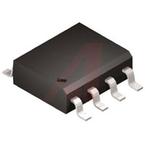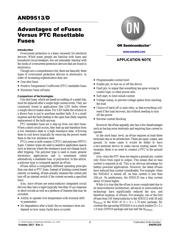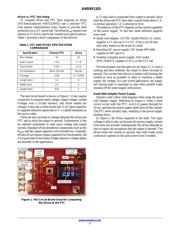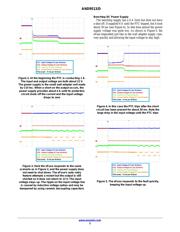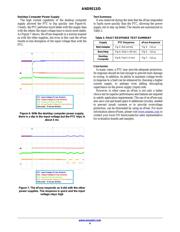herunterladen

© Semiconductor Components Industries, LLC, 2017
October, 2017 - Rev. 2
1 Publication Order Number:
AND9513/D
AND9513/D
Advantages of eFuses
Versus PTC Resettable
Fuses
Introduction
Overcurrent protection is a basic necessity for electrical
devices. While many people are familiar with fuses and
household circuit breakers, few are intimately familiar with
the kinds of overcurrent protection devices that are found in
electronics.
Though not a comprehensive list, there are basically three
types of overcurrent protection devices in electronics. In
order of increasing sophistication they are:
• One-shot fuses
• Positive Temperature Coefficient (PTC) resettable fuses
• Electronic fuses (eFuses)
Comparison of technologies
One shot fuses, which are based on melting of a metal link,
must be replaced after a single high current event. They are
commonly found in applications like LED bulbs where
a simple device makes sense. For LED bulbs the solution to
a blown fuse is just to purchase another bulb. It is a small
expense and the fault leading to the open fuse likely requires
replacement of the bulb anyway.
PTC resettable fuses are a step-up from one shot fuses.
When a short circuit occurs, they heat up and transition from
a low resistance state to a high resistance state. Allowing
them to cool down (typically by removing the power) resets
them to the low resistance state.
PTCs come in both ceramic (CPTC) and polymer (PPTC)
types. Ceramic types are used in sensitive application spaces
such as telecom where the resistance must not change much
after tripping. The polymer type is used in many general
electronics applications and is sometimes called
alternatively a resettable fuse, or polyswitch. In this article,
a polymer type is compared against an eFuse.
eFuses utilize a completely different operating principle
than one-shot or PTC fuses. Instead of limiting current based
entirely on heating, eFuses actually measure the current and
turn off an internal switch if the current exceeds a specified
limit.
Also, since eFuses are semiconductor integrated circuit
devices they have a rapid (typically less than 10 ms) response
to short circuits as well as a plethora of features that may be
included:
• Ability to operate over temperature with minimal shift
in parameters
• No degradation after a fault; the on resistance does not
depend on how many faults have occurred
• Programmable current limit
• Enable pin, to turn on or off the device
• Fault pin, to signal that something has gone wrong to
control logic or other power rails
• Soft-start, to limit inrush current
• Voltage clamp, to prevent voltage spikes from reaching
the load
• Choice of latch-off or auto-retry, so that everything will
reset if the load recovers, but without needing to turn
off the power
• Reverse current blocking
However, the eFuse arguably also has a few disadvantages
such as having more terminals and requiring bias current to
operate.
At the most basic level, an eFuse requires at least three
terminals due to its architecture. These are input, output, and
ground. In some cases it would be better to have
a two-terminal device to make layout routing easier. For
example, there is no need to connect a PTC to the ground
plane.
Also, since the PTC does not require a ground pin, current
only flows from input to output. This means that no bias
current is required at all. This is an obvious advantage for
battery-powered applications. However, the latest eFuses
have reduced bias current considerably. For example, when
the NIS5452 is turned off, its bias current is less than
100 mA. Its predecessor, the NIS5135 has a bias current
about 10 times higher.
While it is true that the eFuse is more complicated due to
its semiconductor architecture, advances in semiconductor
technology have significantly reduced the size, and
therefore expense, of eFuses. For example, one of the first
eFuses from ON Semiconductor is the NIS5112 with 30 mW
R
DS(on)
in the SOIC−8 (5 × 4 × 1.75 mm) package. By
contrast the upcoming NIS5020 is in a much smaller (3 × 3 ×
1.0 mm) DFN10 package and has half the R
DS(on)
.
www.onsemi.com
APPLICATION NOTE
Verzeichnis

